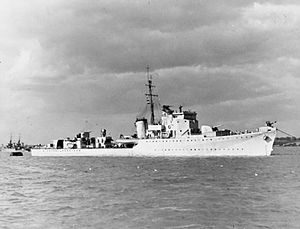HMS Hambledon (L37)

HMS Hambledon during World War II.
|
|
| History | |
|---|---|
|
|
|
| Name: | HMS Hambledon |
| Namesake: | A fox hunt in Hampshire, England |
| Ordered: | 21 March 1939 |
| Builder: | Swan Hunter, Newcastle upon Tyne or Wallsend |
| Laid down: | 8 or 9 June 1939 |
| Launched: | 12 December 1939 |
| Completed: | 8 June 1940 |
| Commissioned: | 8 June 1940 |
| Decommissioned: | December 1945 |
| Identification: | pennant number: L37 |
| Honours and awards: |
|
| Fate: |
|
| Badge: | On a red field, a gold fox's mask and two gold brushes in saltire |
| General characteristics | |
| Class and type: | Hunt-class destroyer |
| Displacement: |
|
| Length: | 280 ft (85 m) |
| Beam: | 29 ft (8.8 m) |
| Draught: | 10 ft 9 in (3.28 m) |
| Propulsion: |
|
| Speed: | 27½ kts (26 knots full) |
| Range: | 3,500 nmi (6,480 km) at 15 knots (28 km/h) / 1,000 nmi (2,000 km) at 26 knots (48 km/h) |
| Complement: | 146 |
| Armament: |
|
The second HMS Hambledon was a Hunt-class destroyer of the Royal Navy in commission from 1940 to 1945. She was a member of the first subgroup of the class, and saw service through most of World War II.
Hambledon was ordered under the 1939 Naval Building Programme from Swan Hunter, Newcastle upon Tyne, on 21 March 1939. She was laid down on 8 or 9 June 1939 and launched on 12 December 1939. She was completed on 8 June 1940, and immediately commissioned, under the command of Commander Stephen Hope Carlill, RN with the pennant number L37.
Upon commissioning, Hambledon immediately began acceptance trials, which she completed successfully later in June 1940. She then proceeded to Portland for work-ups, during which she deployed with the British destroyers Atherstone, Fernie, Inglefield, and Imogen to escort the minelayers Menestheus, Port Napier, Port Quebec, and Southern Prince of the 1st Minelaying Squadron as they laid the first section of the Northern Barrage north of North Rona in Operation SN1. On 12 July 1940, increased German activity in the English Channel prompted the Royal Navy to transfer her work-ups north to Scapa Flow in the Orkney Islands, and she completed them there later in July 1940 and was assigned to a flotilla based at Sheerness, charged with patrol and convoy defence duties in the English Channel and along the east coast of Great Britain. On 31 August 1940 she and her sister ship Garth rendered assistance to Royal Navy ships that had struck mines in the North Sea off the coast of the Netherlands, rescuing the survivors of the sunken destroyer Esk and standing by the badly damaged destroyer Express, which had lost her bow in a mine explosion, until tugs arrived to tow her to safety.
...
Wikipedia
